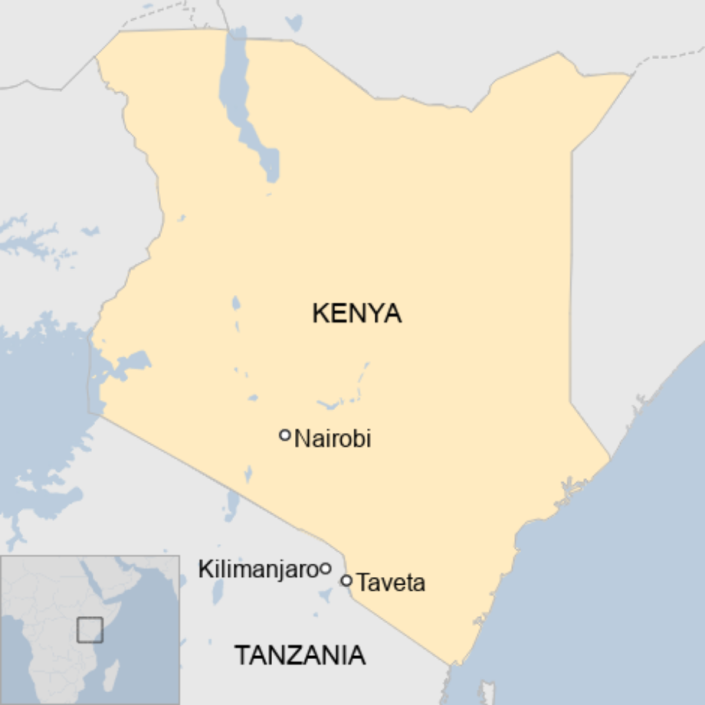
Sickle cell disease affects more people in African countries than anywhere else in the world. BBC Africa Eye has joined an activist on the issue in a town in Kenya where almost a quarter of the population lives with the genetic disease.

In the small town of Taveta, located in Kenya’s Taita Hills near the border with Tanzania, families sat on every available bench under a canopy at a local health clinic. Those who couldn’t find a place stood or sat on the grass.
“Who here has sickle cell disease? asked Lea Kilenga Bey, the woman at the front, from whom they were all waiting to hear.
“All of us,” they shouted in unison, meaning either they carry the genetic mutation or they’re caring for someone who does.
In this bustling market town at the foot of Mount Kilimanjaro, with a population of just 22,000, nearly one in four residents have sickle cell disease, one of the highest rates of genetic disease in the country.
The red blood cells of a person with sickle cell disease, which are normally round, are shaped like a crescent moon or a sickle and cannot carry enough oxygen around the body. People with sickle cell disease can experience episodes of severe pain that sometimes last for weeks.
According to the World Health Organization (WHO), two-thirds of people affected by sickle cell disease in the world live in African countries.
It is the most common genetically acquired disease in the region, and survival statistics are stark.
More than half of children born with sickle cell disease will die before the age of five, usually from an infection or severe anemia. Some medical journals claim infant mortality rates as high as 90%.

A woman from the clinic raised her hand to ask a question.
“They say a person with sickle cell disease cannot live past 20. They only reach 15 and the most they can live is 18.”
Ms Bey pointed out that she was diagnosed with sickle cell disease when she was six months old and survived – she is now in her 30s.
“It’s a curse,” shouted another woman.
In 2017, Ms. Bey founded Africa Sickle Cell, a non-governmental organization focused on improving the lives of people with sickle cell disease. She regularly visits communities to raise awareness of the genetic disease, but has returned to Taveta, her hometown, to help support people there.
“Many communities attribute sickle cell disease to ancestral curses, to witchcraft,” Ms Bey told BBC Africa Eye.
“It’s a situation for anything unknown in the community. People form their own stories around them. So I had to go and tell people that sickle cell disease isn’t witchcraft. This are not ancestral curses. This is something we can fix.”
One of the main challenges for people with sickle cell disease in Taveta and other towns in Kenya is access to medication.
“Either Food or Drugs”
Daily treatment is needed for people to lead normal lives: antibiotics to prevent infections, medicines to treat blood cells, and dietary supplements like folic acid to fight anemia.

“The majority of people who have less than $1 [£0.80] or $2 a day will not sacrifice their house meal to buy this expensive medicine,” Ms. Bey said.
“It’s either the meal or the medicine.”
She knows better than anyone what it’s like to experience what’s called a sickle cell crisis – extreme pain caused by a blocked blood vessel, which can affect any part of the body.
Ms Bey recorded video diaries of her sickle cell crises. Entrenched in her bed, without any medication, she stares at the camera, her eyes half-closed, trying to explain how excruciating the pain is.
She doesn’t want others to suffer.
In Taveta, she also joined a group of people protesting at the local hospital, demanding better treatment.
“We are given expired medicine,” a woman told him holding a blister pack of tablets.
“So many people died because they couldn’t get proper medical care,” said another woman.
“I told a friend that I was giving my child medicine, but her eyes were still yellow. She found out that the medicine had expired,” said another.
Jaundice is a common symptom of sickle cell disease. Yellow eyes are a regular feature of this town.
Albert Loghwaru, 50, was the leader of the group. Two of her children had been diagnosed with sickle cell disease. They were then stigmatized when there were so many in Taveta living with the disease.
“People here would call us two things. It’s either we had demons sucking our child’s blood or we’re HIV positive.”
Mr. Loghwaru is determined in his fight to gain access to treatment for his community.
“We have to find a way to help these people.”
As a result of his campaign, along with Ms Bey, a joint hemophilia and sickle cell clinic finally opened in their town, the first in Taita Taveta County.
But that’s not the end of the struggle for Ms. Bey.
“We’re just getting started. It’s not a marathon. It’s not whoever runs the fastest who will win. It’s a relay race.”


